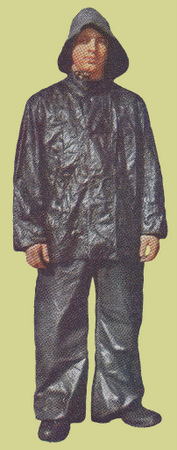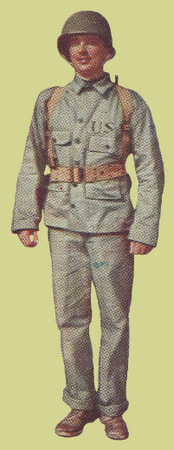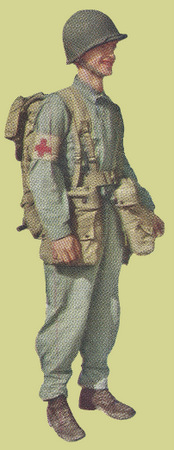A QUICK REFERENCE VISUAL GUIDE

|

|

|
1. Dungaree Work Uniform A work coat made of blue denim with two lower pockets and matching trousers. The sailor in the figure wears a sweater underneath for warmth, but a cotton chambray work shirt could be worn with this set in warmer conditions. Although the Navy adopted herringbone twill utility uniforms, the denim working uniform continued in production and was issued throughout the war. |
2. Undress Blue Service Uniform A general duty working uniform made of wool for the enlisted man that was worn in temperate zone weather conditions. The "undress" designation indicated that the uniform was not meant for dress wear. Undress uniforms were worn with or without the neckerchief depending on the Sailor's job designation. The trousers were the same type worn with the dress blue uniform, but the jumper was simplified in construction and not adorned with white piping. |
3. Undress White Service Uniform A white cotton hat, jumper, and trouser combo worn by Enlisted Men in warm and tropical climates. This was a general duty working uniform. The trousers were button fly and otherwise of traditional design; not having the 13-button broadfall front and tie back of the blue wool trousers. |

|

|

|
A four-piece woolen uniform worn by enlisted Men for dress wear. The pieces included a cap, jumper, neckerchief, and trousers. The jumper had finished cuffs with white piping as well as a back flap that had the same white piping along its border. These features set it apart from the blue undress jumper. The blue trousers had the traditional 13-button broadfall front opening, a lace up back to adjust for size, and distinctive flared bottoms. |
5. Dress Blue Service Uniform & Winter Coat Here, worn over the blue wool uniform, is a warm wool winter coat, popularly known as the "pea coat". It is fully lined and had a large roll collar for warmth. The ten button, double breasted front closure, and navy blue kersey wool gave the coat a fashionable and classic look; it is heavily copied for civilian wear. The large plastic buttons have the traditional Navy symbol of the fouled anchor impressed upon them. |
6. Dress Blues/Shore Patrol This is the dress blue uniform pictured in figure 4, adapted for field use. For shore patrol, the trouser bottoms are now tucked inside canvas leggings for protection. A black high-top shoe was prescribed for wear with leggings instead of the regular low quarter shoe. Accoutrements and equipage are worn over the jumper. |

|

|

|
7. Dress Blues/Police The dress blue uniform again adapted for field use; see figures 4 and 6. This Navy policeman wears the M-1 steel helmet for added head protection as required by his work. |
8. CPO Dress Blue Uniform A cap, dress jacket, and trouser combination similar in appearance to the officer's uniform, but worn by enlisted personnel who achieved the minimum rank of Chief Petty Officer. The CPO jacket is distinguished by its eight button double breasted front. The gilt buttons were smaller in size than those prescribed for the officer's blue uniform. The fouled anchor insignia was pinned directly to the cap and did not have a backing. A blue cap was also worn with this uniform. |
9. Officer's Khaki Work Uniform A three-piece matching, cap, jacket, and trouser working uniform made in cotton khaki and generally worn in warm to tropical conditions. The jacket had a brief three button front closure, was unlined, had a belted mid-section, and large, expanding bellows lower pockets. There were a series of loops on the shoulders for attaching officer's rank shoulder boards. |

|

|

|
10. Officer's Grey Work Uniform Essentially similar in configuration and material type to the khaki officer's work uniform in figure 9. The grey uniform was short lived and was primarily a war time experiment to offer better camouflage properties while aboard ship. The color, so called "battle ship grey", was similar to that in which ships were painted. |
11. Officer's Aviator Winter Uniform Typically made of green wool elastique, this working uniform was similar in configuration to the khaki and grey uniforms in figures 9 and 10 respectively. Aviators are often seen wearing this uniform with brown shoes. The rank insignia is displayed around the cuffs of the jacket. |
12. Officer's Dress Blue Uniform A three-piece uniform including cap, jacket, and trousers made from various types of wool, such as gabardine and elastique. The double breasted jacket was fully lined and had six adorning gilt buttons bearing an eagle clutching an anchor. Rank insignia was worn around the lower sleeve. |

|

|

|
13. Officer's Winter Dress Blue Uniform This is the same Officer's uniform shown in figure 12, but now worn with the blue cap. For cold weather, officer's had two types of full length blue overcoats that could be worn with this uniform; a trench style coat with a removable wool liner, and a wool double breasted coat adorned with gilt buttons. |
14. Officer's Summer White Uniform A white officer's uniform usually made in cotton twill or sometimes summer weight worsted wool. The styling of this uniform is much the same as those shown in figures 9 through 11. |
15. Winter Deck Uniform A heavy weight, wool lined, three-piece, blue uniform consisting of helmet, jacket, and overalls to protect against cold weather exposure. This uniform was similar in styling to the Army's winter combat uniform. These uniforms were worn in working conditions on the topside of ships when extra warmth was needed. This uniform was redesigned before war's end with the color changing to green. |

|

|

|
16. Foul Weather Uniform A classic style rain suit worn on the topside of ships in stormy seas. This uniform consisted of oilskin jacket and trousers with sou'wester style hat. |
17. Wet Weather Uniform A parka style wet weather uniform in green worn by landing craft crews, ground forces, and the like. This newer wet weather uniform utilized synthetic resin coatings, instead of rubber or oil coatings, to achieve resistance to water. The top was a pull-over with attached hood and three buckle throat closure. Later models of this parka were designed with a lace up throat closure. |
18. Tropical Combat Uniform A two-piece herringbone twill work and tropical combat uniform similar to army designs. The jacket shows USN stamped over the left pocket, which was the practice of the time for Navy HBT uniforms. The Navy jacket had the large front pockets set noticeably lower so not to make the wearer top heavy in water. The trousers were identical to Army first pattern HBT trousers. Later, the Navy wore the Marine Corps style HBT design, but in a darker shade of green. |

|

|

|
19. Temperate Zone Combat Field Uniform This figure shows a ground forces trooper wearing the Army olive drab field jacket over his herringbone twill uniform. The Army jacket can be identified by its shoulder loops. The Navy produced a similar jacket, marked with USN over the left breast, without shoulder loops, and generally in a darker shade of green. This illustration shows that the different services regularly wore one another's uniform components when practicable or necessary. |
20. Corpsman's Combat Field Uniform This illustration shows a Navy Corpsman loaded with his medical gear, ready for field duty. He wears a herringbone twill one-piece work suit, illustrating this garment's widespread and varied use. Herringbone work uniforms were routinely used as a combat uniform in warm and tropical environments by all services. |
21. One-Piece Combat Uniform Another example of Navy ground force personnel utilizing the protective herringbone one-piece as a warm weather combat uniform. The one-piece was often desired in this role, versus the two piece uniform. Its uni-body construction with ankle and cuff tabs offered superior protection against mosquitoes and the other multitudes of biting insects found in tropical conditions. Note in the illustration the use of the ankle tabs to close the leg opening around the boots. |
 |
MORE ABOUT THESE IMAGES
These uniform images are from a pamphlet entitled "How to Recognize the Armed Forces of the United States". It was published in the French language and was intended to help Europeans readily identify United States servicemen by showing illustrations of them in uniform. Also included were close-ups of insignia worn by the Army, Navy, and Marines. It was produced and distributed in the 1940's by the War Department Office of the United States Government. Period materials are a good source of information to help understand and view accurate images of the uniforms and clothing worn by U.S. Troops in WWII. These types of materials were plentiful during the time. As millions of men and women joined or were drafted into the armed services all types of publications appeared to help citizens recognize and identify the various uniforms. There were magazine and newspaper articles, numerous small inexpensive books, and official publications such as this, all to help the citizenry know who was who. These publications can still easily be found today in antique malls, resale shops, and online auctions. The front and back covers of this pamphlet appear to the left and right respectively. |
 |